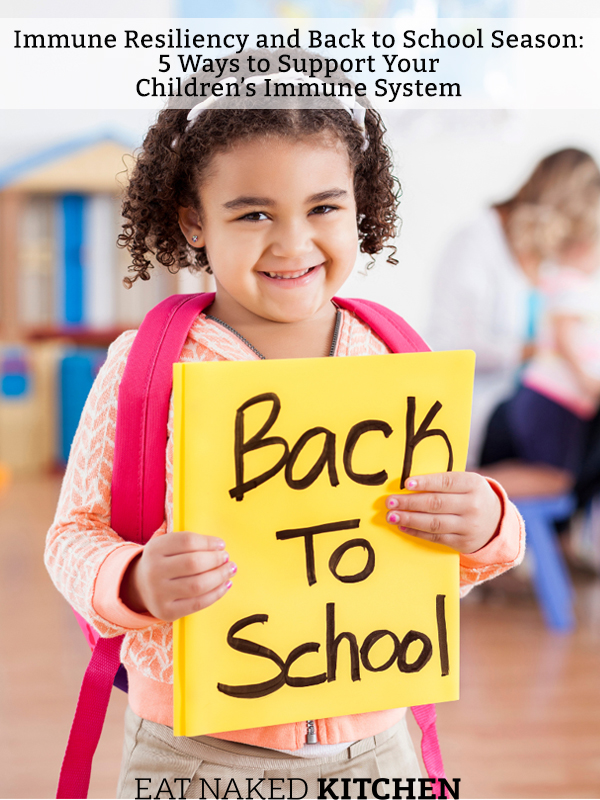If you’re a parent, you’re “in it” right now. Back-to-school season. And it’s still a wild, weird, and somewhat terrifying world out there when it comes to viruses.
Regardless of where you live or what the requirements are for your kids, regardless of whether you or they have been vaccinated or not, immune resilience has never been more important. Here are 5 things you can do to help their immune systems meet whatever challenges they face:
1) Avoid sugar
I know, I know. I’m a bit of a broken record on this one. But here’s the thing, cutting sugar is one of the most important dietary changes when it comes to nourishing your immune system. Here’s why:
For one, sugar promotes low-grade chronic inflammation [1], [2] and inflammation, by definition, is the engagement of the immune system.[3] For another, sugar temporarily suppresses an important aspect of the immune system: the phagocytic activity of macrophages. [4] What this means is that sugar temporarily stops a key component of your immune system from doing its job. Specifically the macrophages, or “big eaters”, aren’t able to phagocytize, or “eat up” bacteria and other debris.
The thing about sugar and kids is that it sneaks into our kids’ food even more than it does into ‘adult’ food and oftentimes we’re feeding them loads of it without realizing it. Here are some of the biggest culprits:
- Flavored yogurts and yogurt drinks
- Cereals, granola and granola bars, oatmeal, and “breakfast bars”
- Juice of all kinds – even “natural”, “organic”, and “not from concentrate.” (Side note: because fruit juice is one of those things that is perceived as healthy, I just did a quick search to check sugar levels for a clean brand of fresh-pressed organic juices and their bottle of orange juice has a grand total of 49.4g of sugar in it. When you look at their label, you’ll see 26g of sugar per serving – already an extremely high number – but this is actually misleading given their serving size is defined as 8oz, but this bottle has 15.2oz in it. This means the actual sugar content is nearly double what a first read of the ingredient label would suggest. Do you see how sneaky this is? And this is a brand that is pitching itself as the healthy alternative.)
- Nut butters and jams
- Crackers and chips
- Ketchup, mayo, mustard, and other condiments
- Fruit snacks such as fruit leathers and chews
- Any packaged snack or “kid” food – even if labeled organic, gluten-free, paleo, vegan, all-natural, or any other healthy-sounding label
Notice that I haven’t even mentioned a straight-up dessert item such as cookies, cake, pastries, or ice cream. If you want to help strengthen your child’s immune system, then consider looking for low-sugar or unsweetened options. (As I write this, I realize a great follow-up post to this article would be some of our favorite brands of unsweetened alternatives – we’ll share that in the coming weeks!) In the meantime, here’s an article on healthier swaps for your child’s lunchbox.
2) Get enough sleep
The next key factor in keeping your kids’ immune systems strong is to make sure they’re getting enough sleep. Kids need a lot of sleep – more than we think they do. For the really littles, ages 3 to 5, children should sleep between 10-13 hours in a 24-hour period (that includes naps if they are still napping). Children between the ages of 6 and 12 require 9 to 12 hours of sleep a night and teenagers ages 13 to 18 need between 8 to 10 hours a night. [5] For most kids, with the exception of teenagers, this is best achieved by ensuring an earlier bedtime.
When it comes to your immune system, it’s no accident that when you’re sick, you crave sleep. Your immune system is most active when you rest and sleeping when you’re sick gives your body the opportunity to dedicate its full set of resources to the vitally important task at hand: fighting the virus or bacteria that got you sick in the first place.
But it’s not only during illness that sleep is important. In a sleep study described by Dr. Matthew Walker in his outstanding book Why We Sleep, study participants were (voluntarily and willingly) infected by the virus responsible for the common cold. They monitored many different factors in their body’s immune response, one of which was the amount of sleep they experienced in the week prior to exposure to the virus. There was a direct correlation between the amount of sleep and the likelihood of being infected by the virus and catching the cold. In those sleeping 7 hours or more per night the week before exposure, there was only an 18% rate of infection; in those sleeping 5 hours on average, the infection rate was almost 50%. Given the severity of the virus we currently have going around, this should give pause to ALL of us, kids and adults alike.
Back to kids. How do you know if your child is getting sufficient sleep?
Here’s an easy litmus test: is your child waking on their own, with lots of energy and ample time to eat, get dressed, and get to school? If so, they are likely getting enough sleep. On the other hand, if you or an alarm clock has to wake them, they’re groggy and tired on waking, and the morning is a rushed and cranky experience, then it’s likely they’re not getting sufficient rest. Try moving their bedtime back by 30-90 minutes and see if that helps. Of course, this adjustment will take some time – consider moving it back by 10-15 minutes every couple of days until they are accustomed to an earlier bedtime. Also, remember that good sleep hygiene habits apply to your children as much as they do to you: turn off all screens 60-90 minutes before bed, dim the lights in this same time window, and have a regular, predictable bedtime routine that will cue their body that it’s time to settle down and sleep.
Now, let’s talk for a moment about teenagers. One of the fascinating things that happen during the teenage years is that their daily sleep rhythm moves forward by several hours, meaning: they naturally stay awake later and sleep in much later during these years. This is well documented in the book I referred to above, Why We Sleep by Dr. Matthew Walker, and while we don’t know exactly why this happens, we know that it does happen and we can trust our body’s innate intelligence that it’s doing it for a reason. Sadly, many high school schedules make a teenager’s natural inclination to sleep in really challenging – but do what you can to allow flexibility in their schedule for this natural and important shift.
3) Get moving!
For some kids (like my youngest daughter who literally cannot sit still), this is a no-brainer. Without sufficient activity, they’re crawling off the walls and it seems the goal for every day is to keep them moving enough to tire them out so they’ll actually sit down at the dinner table. But for other kids (like my oldest daughter who would far prefer to settle in with her sketchbook than anything else), movement isn’t as much of a given.
Natural predispositions aside, daily exercise and activity are essential for our children’s wellbeing. While the research directly correlating physical activity with immune function in pediatric populations is still nascent, there is some evidence that regular physical activity is associated with a reduction in illness and infection in children. Furthermore, the top co-morbidity with that current “thing” that’s going around is poor metabolic health, and regular exercise is one of the key strategies in ensuring metabolic health.
The key? Get your kids moving on a daily basis for at minimum an hour a day! Aside from the immune benefits, you’ll reap many other benefits of healthier, happier kids overall.
(And as a side note, there is increasing evidence [6] that physical activity in kids can decrease the likelihood of them developing autoimmunity later on in life. For those of us with autoimmune diseases of our own to manage, this is an additional and compelling reason to make sure our kids are moving!)
4) Get them outside
In many ways, this action item is directly related to movement. Getting kids outside makes exercise and activity far easier, more fun, and can enhance the health benefits of exercise. Getting outside exposes kids to the sun for that all-important nutrient, vitamin D, which is essential for immune health. It gives them access to fresh air, to the natural world, and to the health-promoting negative ions you find in natural environments such as forests, parks, or near bodies of water. Plus: it’s fun! Getting outside can help kids “get the willies out” which is an essential part of their own stress management and mental health, as much as it is essential for their physical wellbeing.
While you’re at it – get out there with them. 🙂 It’s good for you, too!
5) Proactively provide immune-supportive nutrients
All of the above are absolutely essential to our children’s immune resilience, and yet we always want an extra layer of protection – especially with all the variants of that thing that are going around. There are certain key nutrients that you can easily supplement your children’s diet with that can help their immune system to be even more capable if they are exposed to something pathogenic.
- Multiple vitamin-mineral-trace element supplement – this will cover most of our bases. This should include an adequate amount of vitamin d as well as the right proportions of vitamins, minerals, and trace elements without danger of toxic build-up and without side effects. We talked about vitamin D above, and while time outside is essential, it’s often not enough on its own to ensure optimal vitamin D levels. Of note, there is still disagreement about what true Vitamin D sufficiency in the pediatric population should be, but <25nmol of 25-OH-D measured via serum is considered deficient. We know that there is a significant difference between “sufficient” and optimal, and some research [7] suggests that optimal should be closer to 70nmol. Because vitamin D is so essential to immune health, is so difficult to get from dietary sources, and is challenging to get from skin exposure alone (in part because we typically lather our kids in sunscreen when they DO go outside, and this blocks the body’s ability to access vitamin D from sunlight), supplementation is a very good idea. Studies show that a high percentage of children in North America and other developed countries eat less than the minimum daily allowance of many essential nutrients. So getting adequate amounts and proper balance of nutrients is needed not only for maintaining good health but also for satisfying the special nutritional demands of growth and development during childhood.
- Probiotics – with over 80% of our immune system living in and around the digestive tract, gut health is intimately connected to our immune health. A daily probiotic is an essential support for so many reasons – immune health is just the beginning.
- Omega (Fish oil) – Think of omega-3 as an essential building block that can help your child to concentrate and learn new information. It can help support cardiovascular health, brain function, and a positive mood, as well as healthy joints, hair, skin, and nails and modify markers of immunity and potentially be protective against allergies [8]. If your child doesn’t get enough from dietary sources, this can be a helpful addition.
If you’re looking to stock up on an immune “kit” for your kids, we created a bundle of our favorite kid-friendly supplements in the Eat Naked Kitchen dispensary. You can find more information here.
What are your immune-strengthening strategies as we enter into the school year? Please share in the comments below.
Find this article helpful or know a parent who could benefit from the information offered here? Please share it!

References
1 [https://www.ncbi.nlm.nih.gov/pmc/articles/PMC5986486/] 2 [https://www.ncbi.nlm.nih.gov/pubmed/16904534] 3 [https://www.medicalnewstoday.com/articles/248423] 4 [https://www.ncbi.nlm.nih.gov/pubmed/29996768] 5 [https://www.ncbi.nlm.nih.gov/pmc/articles/PMC4877308/] 6 [https://pubmed.ncbi.nlm.nih.gov/25892449/] 7 [https://www.ncbi.nlm.nih.gov/pmc/articles/PMC3765249/] 8 [https://www.ncbi.nlm.nih.gov/pmc/articles/PMC5537898/]






